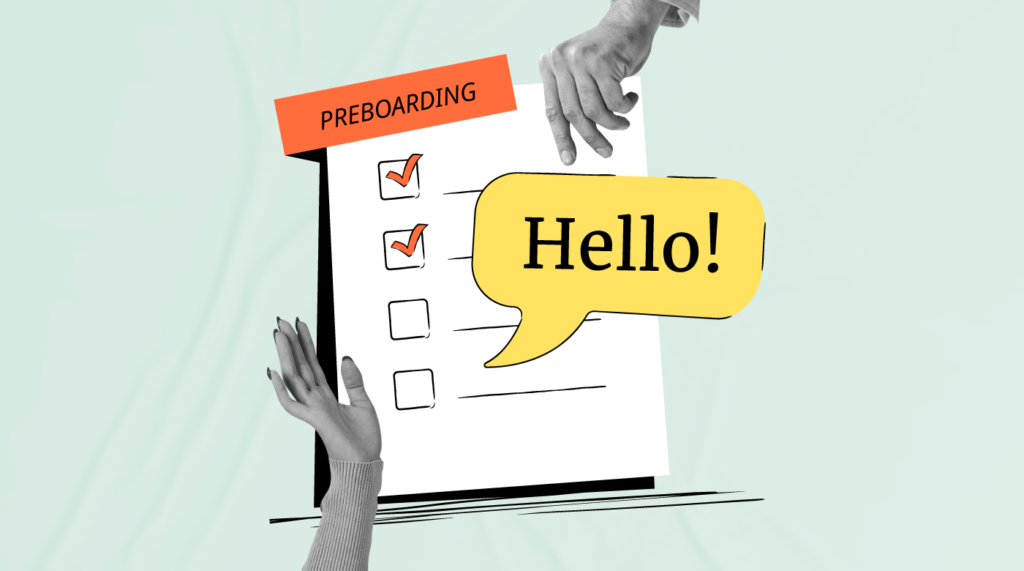Preboarding is the process between a new hire accepting an offer and their first day.
It’s a crucial part of the longer onboarding process and important for helping relieve those day-one jitters.
Here I’ll cover what preboarding is, why it’s important, and how you can create a world-class preboarding process utilizing onboarding software solutions.
What Is Preboarding?
The preboarding period covers when a new hire accepts the job offer and steps into the office (physical or virtual!).
What your organization does, or doesn’t do, during this time can make all the difference in regards to productivity, business risk (think contracts), employee experience, and retention.
Yet, when it comes to preboarding, 64% of new hires receive no preboarding experience.
With this in mind, you can leave a lot on the table if you create an onboarding program that omits preboarding.
It’s an easy win at the end of the day.
Preboarding vs. Onboarding
Onboarding is the process of integrating a new hire into your organization. The onboarding process usually takes around 90 days but can last up to a year in some cases.
By the end of the onboarding process, the aim is to have the new hire integrated into the company culture and clear on their role, expectations, priorities, and goals.
Preboarding is the first part of the wider employee onboarding process.
The idea is to prepare someone for their first day and give them a taste of the culture and their role.
Activities include completing necessary paperwork, reading policy manuals, setting up email accounts, and accessing portals and training materials.
| Preboarding | Onboarding |
| Before someone’s first day | 90+ days after starting |
| Supports orientation | Continues orientation |
| Light touch | Full integration |
What To Include In Your Preboarding Process
Before we get into the specifics, here are some best practices for onboarding and goals that your preboarding process should aim to achieve:
- Give the new hire information such as what their first week will look like or logistics like parking and what to wear in the office.
- Further introduce the culture, their team, and alleviate nerves.
- Ensure they have all the equipment and resources they need before their first day
- Demonstrate that they've made the right choice in accepting your job offer and agreeing to join your organization.
After all, it's likely this wasn't the only job offer they received. It’s common for them to be wondering if they should've accepted that other offer or responded to that recruiter who reached out to them on Linkedin.
With this in mine, here’s what to include in your preboarding process.
Welcome email
To get the ball rolling, you'll want to have a well-crafted welcome email that helps cover the pressing concerns.
Some items to cover here:
- Start date and time
- Arrival information
- Dress code
- What to bring
- First-day agenda
- Employee handbook
- Access to training materials
One idea I’ve seen is to loop in their future team members so that they can welcome their new colleague.
Administrative tasks
You will also want to ask them to complete a few basic administrative tasks before starting.
- Setting up their profile (email, Slack account, employee portal, HRIS.)
- Sending them any equipment they’ll need e.g. laptop
- New hire paperwork.
Welcome pack
As an added touch, many organizations choose to send through a welcome pack with branded swag. This can include:
- T-shirt
- Hoodie
- Hat
- Mug
- Stickers
- Bags
- Waterbottle
- Pen
- Notebook
- Tea
- Coffee
- Vouchers
- Hand-written note signed by their manager and team.
Use Preboarding To Boost Productivity And Retention
It’s estimated that 20% of turnover takes place in the first 45 days. Effective preboarding helps people settle in and feel like they’ve made the right decision, boosting retention and productivity.
However, be cognizant of not overloading people too much. Your preboarding program shouldn’t amount to unpaid work.
Instead, it’s helping to prepare someone for their orientation week and getting them excited about the role.
The key is to give them everything they should know but are afraid or forget to ask during an orientation process, and help ease them in and alleviate those anxieties.
Key takeaways
- Preboarding is part of your onboarding process that takes place after someone has accepted an offer and before their first day
- Preboarding aims to help the new hire prepare for their first day and get them excited about the role and your organization
- Effective preboarding helps get new hires productive more quickly and boosts employee retention.
For further advice on preboarding and onboarding, join the People Managing People Community, a supportive community of HR and business professionals sharing knowledge to help you progress in your career and make greater impact in your org.


